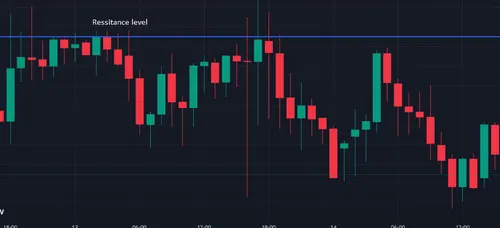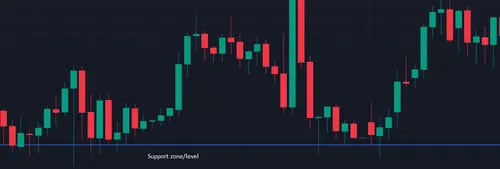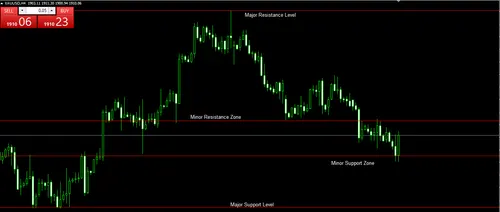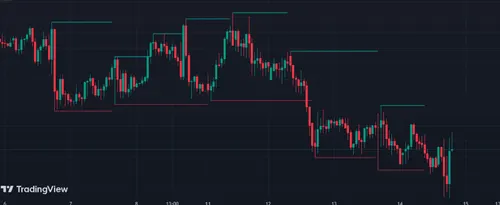Our partner, XM, lets you access a free demo account to apply your knowledge.
No hidden costs, no tricks.

Support and resistance are widely used in technical analysis of Forex and other financial markets. They act like a ceiling and floor for the price and are significant price zones where the price of an asset usually has difficulties moving beyond. Because of this, many traders try to master drawing these lines on the chart and make trading decisions based on these levels. However, it is not as easy as it seems to employ these concepts in actual trading. Below is a comprehensive guide on how to master and use support and resistance levels in FX trading.
When the price tries to go beyond a certain highest price and fails, it forms a resistance zone. A resistance zone is a place where the price is expected to struggle every time. Traders use these levels to anticipate potential reversals and to manage risks. They usually wait for the price to either break out the resistance or fail and pull back, and open a trading position accordingly.

The complete opposite is true for the support level which acts as a floor for price and supports its upward movement. By combining support and resistance levels traders have a powerful tool at their disposal to increase their chances of success in FX trading.

On the price chart, there are levels where the majority of traders place their pending orders. When the price reaches these levels pending orders are triggered and the price immediately reacts by moving in the direction of the majority of positions. Traders use these levels as a place to closely watch for trading signals.
Another way how these levels can form is a self-fulfilling prophecy. If a sufficient number of traders think that a certain level is important they can place pending orders and create a major level in the process.

Correctly drawing support and resistance zones can greatly enhance traders’ profitability by acting as a confirmation element to their trading strategy. Drawing them will help to have a reference to where price might struggle and where trader needs to watch their trading positions closely.
The most basic objective method to draw major support and resistance levels is to find the highest and lowest prices on the chart and draw lines.
With this simple method, it is possible to track the price and define levels where potential signals may form.
There are several ways to draw support and resistance lines. One way is to draw it at the highest price and lowest price, and another way is to draw it at the closing point of the candle or the body of the candle. Usually, minor support and resistance levels are more difficult to draw. A simple method is to draw a line in the zone where the price is reversed most of the time.
Another important fact to remember is that support and resistance are usually zones, not a single point. Price never moves perfectly and it always moves slightly behind those levels. This is why we should think about these levels as zones.

Some traders draw support and resistance levels on each major swing to help them visualize these levels better. But this is for more experienced traders and beginners should stick to simpler methods.
As we have mentioned traders use Support and Resistance to increase their chances of catching high-probability trades. Getting into the intended direction of the market and making a profit is easier when these levels are identified. However, using support and resistance levels alone can be dangerous, and it is always better to combine them with other tools. Buying and selling pressure at support and resistance levels are usually significant and increased volatility may produce many false signals. This is why traders always watch what the price will do and enter only when the movement is confirmed.
Support and resistance can also be used in risk management. The most basic way is to set stop loss slightly beyond these levels. In case of a long position (buy) stop loss should be placed at the current support level. The opposite is true for the short orders (sell).
Placing stops slightly beyond these levels makes it much more difficult for the price to reach your stop loss. This is indeed a very powerful and widely used technique for risk management and every trader should learn it.
The most important mistake to avoid is to use too many lines or technical indicators on the chart. This happens surprisingly often, as beginners try to find a holy grail system and overcrowd charts in the process. Try to be as objective as possible and draw lines where they need to be, like in the examples above.
Another important mistake to avoid is not to use these levels for trading signals without some kind of confirmation tool. Wait for the price to react on these levels and only enter the position when it retreats. In case it breaks the level, wait for it to retest and continue in the breakout direction. Always try to place your stop loss slightly behind these levels and not exactly at these levels, as the price tends to touch and cross support and resistance quite often.
Mastering support and resistance levels is essential for traders to have zones of reference in FX trading. Support and levels are zones on the chart that are difficult for prices to break. Traders use these levels for trading decisions and risk management. While it is never a good idea to use only one confirmation for trading decisions, using support and resistance for stop loss is a must.
Drawing support and resistance zones is straightforward, just draw lines on the highest and lowest prices on the chart. These zones are formed where the majority of traders have pending orders placed.
Incorporating support and resistance into trading strategy can add a powerful tool to a trader’s arsenal of technical tools. This way traders can protect their stop losses and increase their system accuracy.
Our partner, XM, lets you access a free demo account to apply your knowledge.
No hidden costs, no tricks.